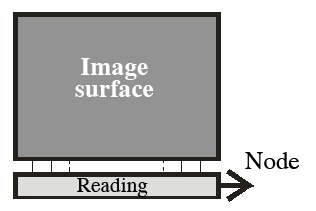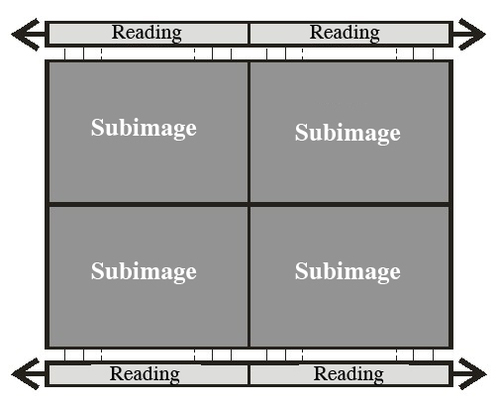
Full frame transfer matrices
Anglo-Saxons use “Full Frame Transfer”, which they shorten by FFT, not to be confused with Fast Fourier Transform.
After integration of the received light, the pixels of the image are read line by line via a serial register which then, synchronizes its contents on the output detection node (Fig. 8 et 9). Any charge has to be transferred from the serial register before the next line is transferred. In full frame matrices, the number of pixels is often in power of two (512 x 512, 1024 x 1024, ...) in order to simplify the memory mapping. Matrices dedicated to scientific applications generally have square pixels in order to simplify the image processing algorithms.
During the reading, photosites are continuously irradiated and it can results in an image presenting smears. This smear will be in the direction of the charge transport in the image area of the matrix.

A mechanical or electronic external shutter can be used to isolate the matrix during the reading in order to avoid the smear. When using a strobe light to generate the image, the use of a shutter is not necessary is the transfer is made between flashes. Is the integration time is much longer than the reading time, then the smear can be considerably important. This situation occurs very often during astronomical observations.

The data transfer speed are limited by the bandwidth of the amplifier and conversion capability of the analog to digital converter. In order to increase the actual speed of reading, the matrix can be divided into sub-arrays that are read simultaneously. In figure 9, the matrix is divided into four sub-matrices. Since they are all read simultaneously, the actual clock speed is multiplied by four. A software then rebuilds the image. This is achieved by a video processor, external to the CCD sensor, where serial data is decoded and reformatted.
Large surface systems often allow the user to select a sub-matrix in reading. So, the user can manage the compromise the transfer rate and the size of the image. It makes it possible to obtain higher rates on a region of interest (sub-block). However, according to the architecture of the matrix, some sensors only allow selecting entire lines and not line fragments. In addition, some cameras have onboard memory whereas others don't. In all cases, the shutter time is the parameter limiting the maximum speed. In the final limit for the camera with no on-board memory, the limiting factor will be the information transfer rate (in Mo/s) to the remote memory (RAM PC, SATA, ...).
The shutter time permits, if sufficiently short, to freeze objects in motion. If the object's velocity is high, its image could result in a blurred smear.
Recently, one can have Full Frame sensor of 8cm by 8cm with “contiguous” pixels measuring 8.75 x 8.75µm, which corresponds to a 57lp/mm resolution. This detector allows acquisition at 2fr/s (Source Fairchild, CCD595 sensor), with a resolution equivalent to photographic films.